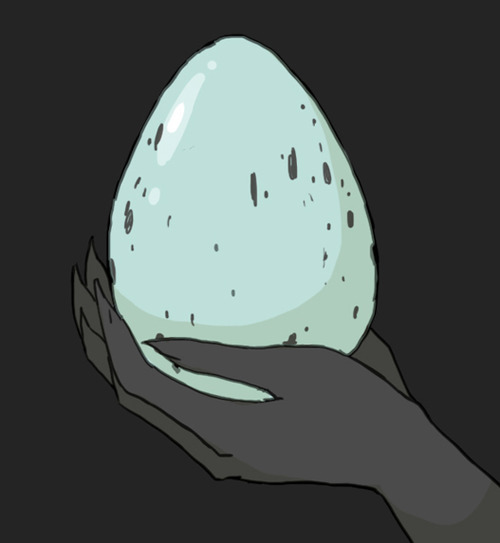Tengu Breeding
I’m literally putting this all into this text box so I don’t forget this stuff (thanks for brainstorming with me Yuki). I probably went into too much detail here but, trust me, this egg stuff is going to be important later on in the story.

Tengu eggs are a pale, greenish-gray color with dark black or brown specks. They are about the size of an ostrich egg (6 inches) and weigh about 3 lbs. Egg laying is much simpler than live birth and can be done without any assistance and relatively little pain.
Tengu females lay eggs once per year, usually 1-2 at a time (a single egg is most common). They do this whether or not the egg is actually fertilized (sort of like human menstruation). This happens around the same time for all female tengu (though females in the same village or household have much closer body clocks). In normal climates, eggs are laid in late winter (February) and in colder places, they can go as late as spring (April). As a result, many tengu have the same birthdays in summer.
Because eggs in a village are laid at roughly the same time, all unfertilized eggs are disposed of with a mutual cremation ceremony. Rather than a somber event, it is more of a way for women to bond and celebrate their femininity.
The first time a female lays an egg is celebrated, and happens around the age of 12-14. Again, this happens at the same time for similarly aged girls. Green mochi is prepared and decorative clothing of the same color is worn.
Fertilized eggs can be discerned when held up to a flame (you can see the opaque embryo). These eggs are kept in a special crib-style nest with thick quilted cloth and feathers. Both parents spend several hours a day cradling them for added body heat, as well (participation of both parents is even more necessary when there are two eggs). Incubation takes around five months. Because it is such a long and sensitive time period, many eggs do not make it to the hatching stage (there is about a 25% success rate). The high rate of failure ensures that children are not named until they actually hatch.
Like most birds, tengu have an egg tooth (sharp notch on the tip of their beak) which helps them chip out of the shell upon hatching. It falls off a few days later and is occasionally saved in the same way human baby teeth are.
Freshly hatched tengu are infamously ugly, looking like a gangly mass of skin with large, gaping eyes. Tengu open their eyes much faster than typical birds (within about an hour). Down feathers appear within a day and normal feathers come in after about a week. For the first few days, hatchlings are fed soft foods such as rice porridge. Because they don’t have or need teeth, they can eat normal adult food after a week (aside from dishes with choking hazards).
De jisuk - Source 20avril2013





 English
English Español
Español Français
Français 日本語
日本語 Русский
Русский CC BY-NC-ND 3.0
CC BY-NC-ND 3.0